Introduction to how to create a pricing strategy
Introduction
When integrating the Resale App onto your website, you can choose the offer option(s) you want to give to your customers: buyout, consignment and store credit.
To provide instant offers for each of these options (buyout, consignment and store credit), you need to create a pricing strategy.
What is a pricing strategy?
A pricing strategy describes your commission structure based on:
- the selected offer option (buyout, consignment, or store credit) by the customer
- the estimated fair market value of the selected item
- the category or brand
- additional attributes (i.e. the model or style for the category handbags)
Your commission structure is the ratio of what you pay to the customer and your target markup (also called profit margin or the percentage that your business keeps). For example, if your commission structure is 60%/40% for the buyout option, you will give 60% to the customer and keep 40%, if the customer chooses the buyout option.
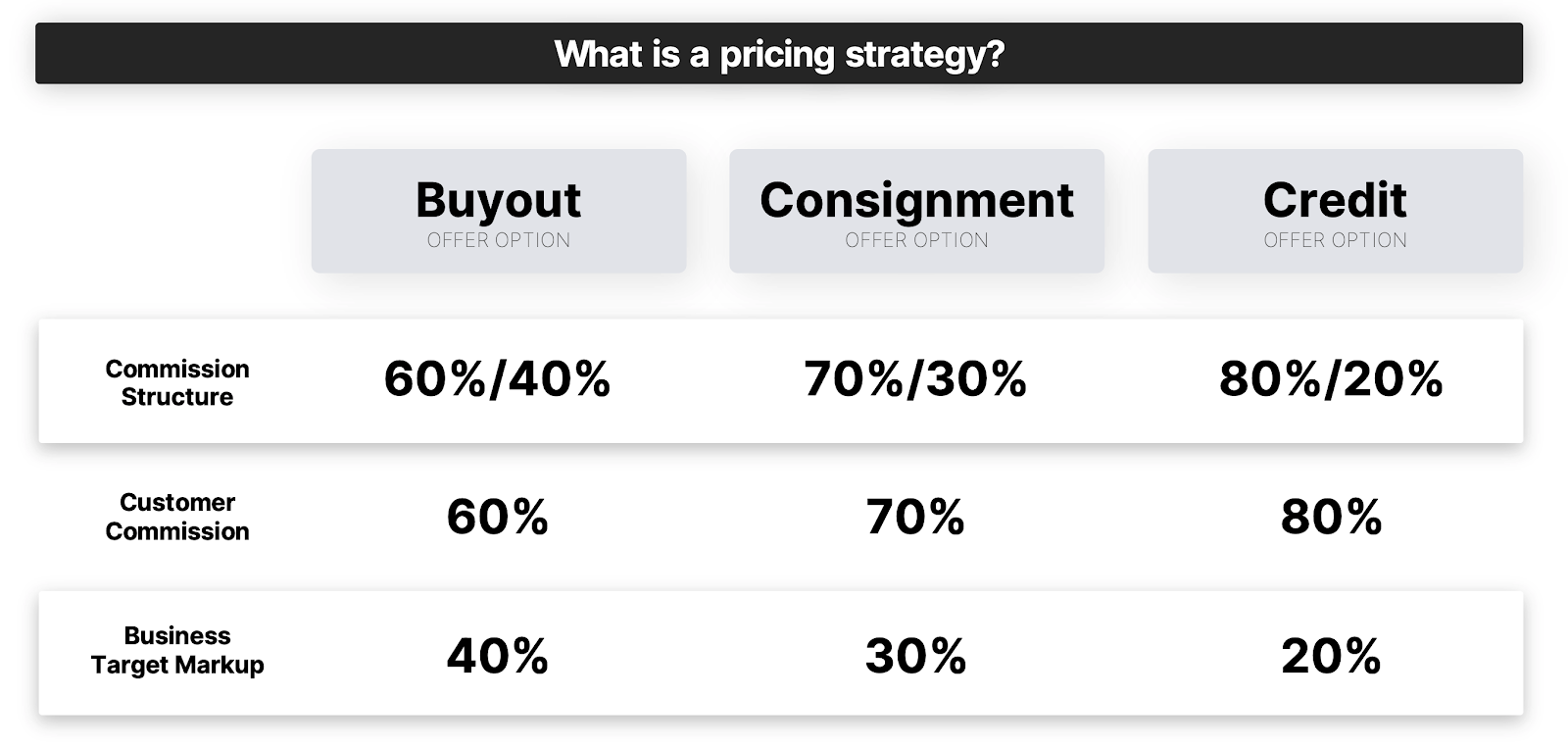 Each week, we collect millions of data points that we use to analyze trends and compute current fair market values for thousands of handbags. Therefore, you need to define the target markup that you want to make for each offer option (i.e. buyout, consignment, and/or store credit).
Each week, we collect millions of data points that we use to analyze trends and compute current fair market values for thousands of handbags. Therefore, you need to define the target markup that you want to make for each offer option (i.e. buyout, consignment, and/or store credit).
For example, if you aim for a target markup of 40% for the buyout option, and the handbag’s fair market value is estimated at $1040, you will offer the customer $624.
Buyout offer: (100%-40%)*1040% = $624 Expected earnings: $1040-$624 = $416
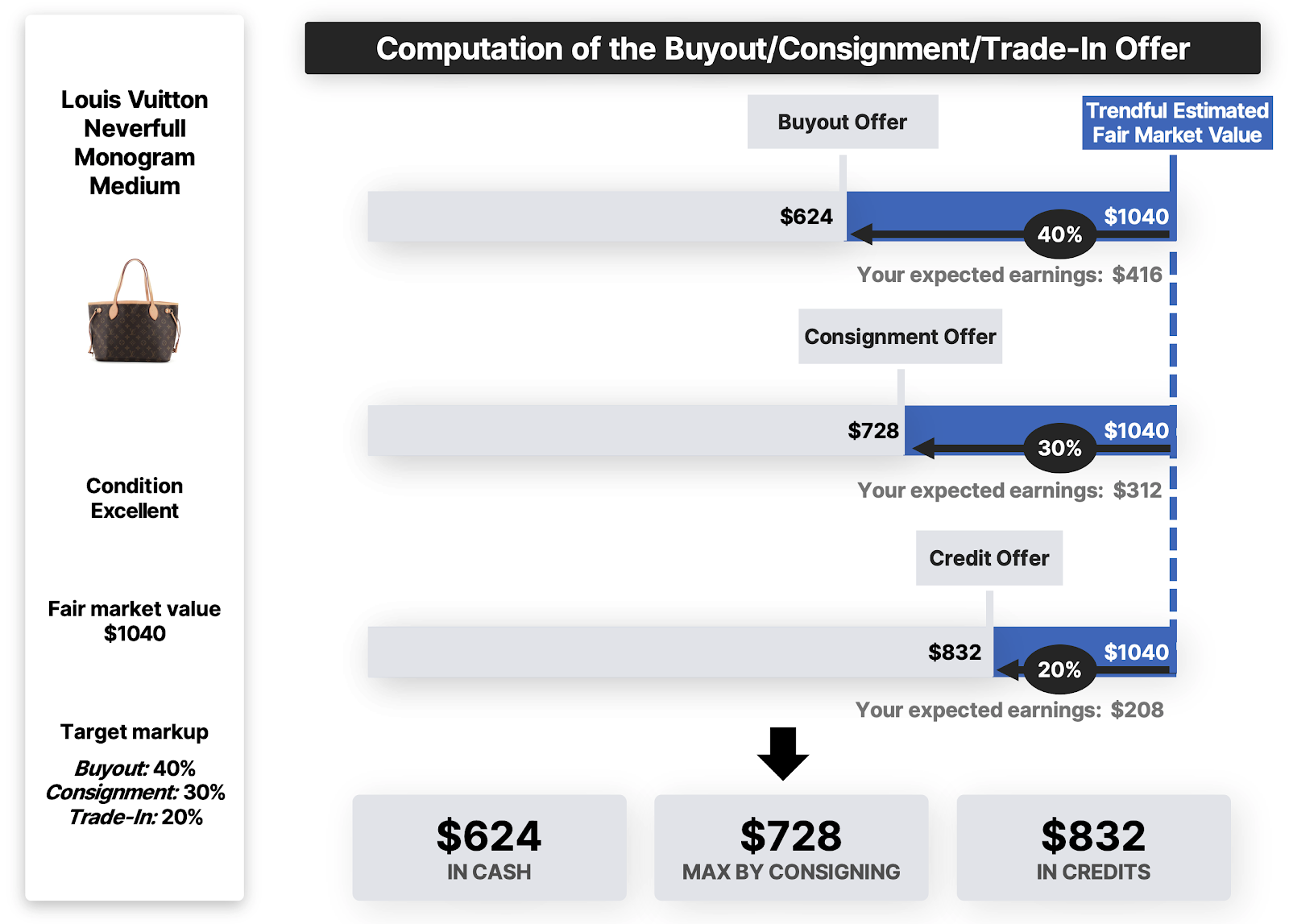 If you want to know more about how we estimate fair market values, read this guide.
If you want to know more about how we estimate fair market values, read this guide.
Alternatively, you can define different target markups not only depending on the offer option but also based on the category, brand, additional attributes or price range. For example:
- You can aim for a target markup of 40% for Louis Vuitton, 30% for Chanel and 50% for all other designers for consignments. In parallel, you can aim for a target markup of 50% for Louis Vuitton and Chanel and 60% for all other designers for buyouts.
- You can aim for a target markup of 60% for all items with a fair market value up to $1000, 40% for items with a fair market value from $1000 to $5000, and 30% for all items with a fair market value over $5000.
- You can choose to offer buyouts only for Louis Vuitton and Chanel and offer consignment for all designers.
- You can choose to provide manual offers for Hermes or items with a fair market value over $5000.
- You can create a pricing strategy based on a combination of all of the above.
And especially, you can update your pricing strategy at any point in time by contacting support@trendful.com.
Since you can specify different target markups based on the offer option, category, brand, additional attributes, and/or price range, it gives you the possibility to create a unique pricing strategy that will respond to your business’s specific needs.
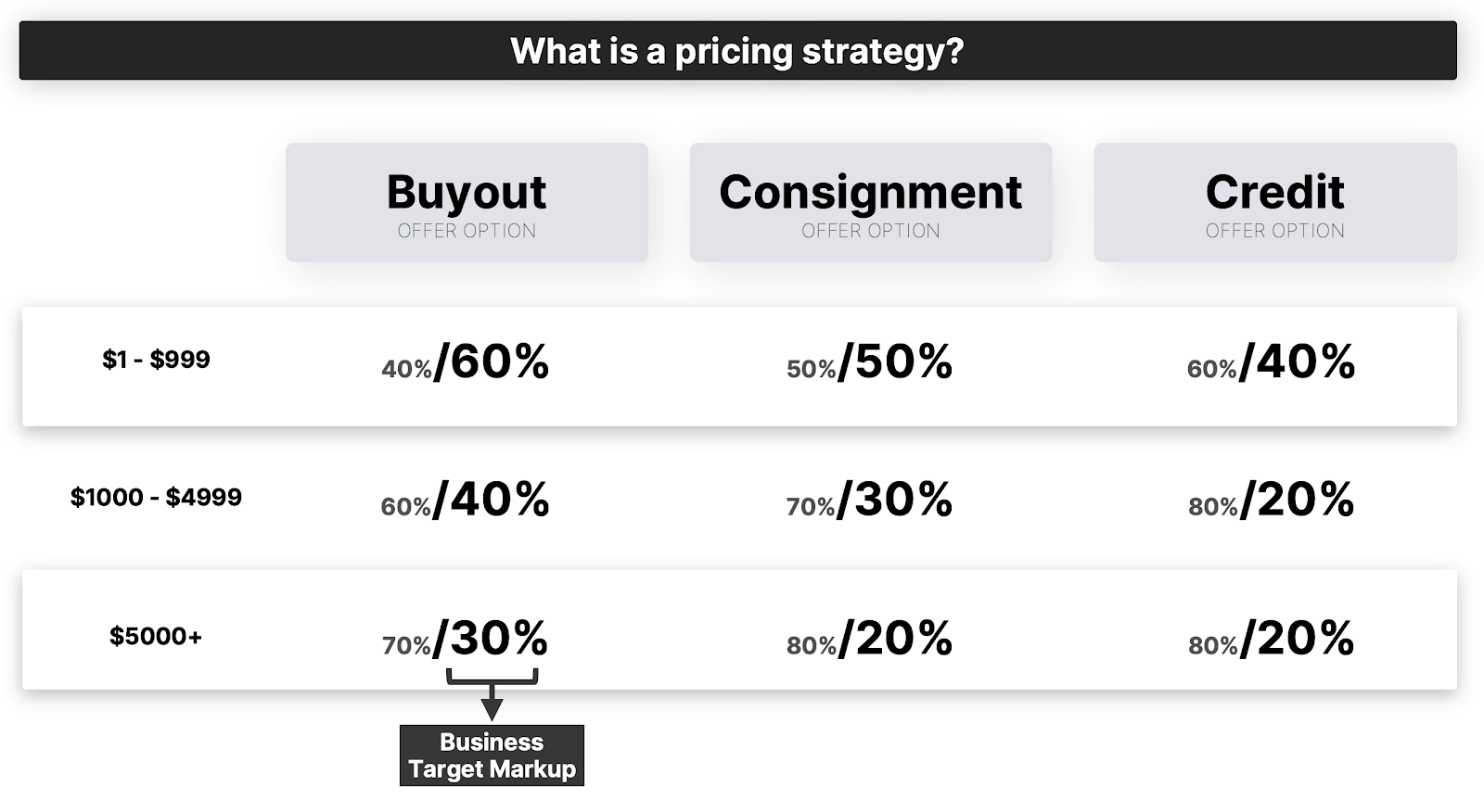
Alternatively, you can also choose to solely provide manual offers. In this instance, the Resale App won't show any prices. Manual offers will display as shown below:
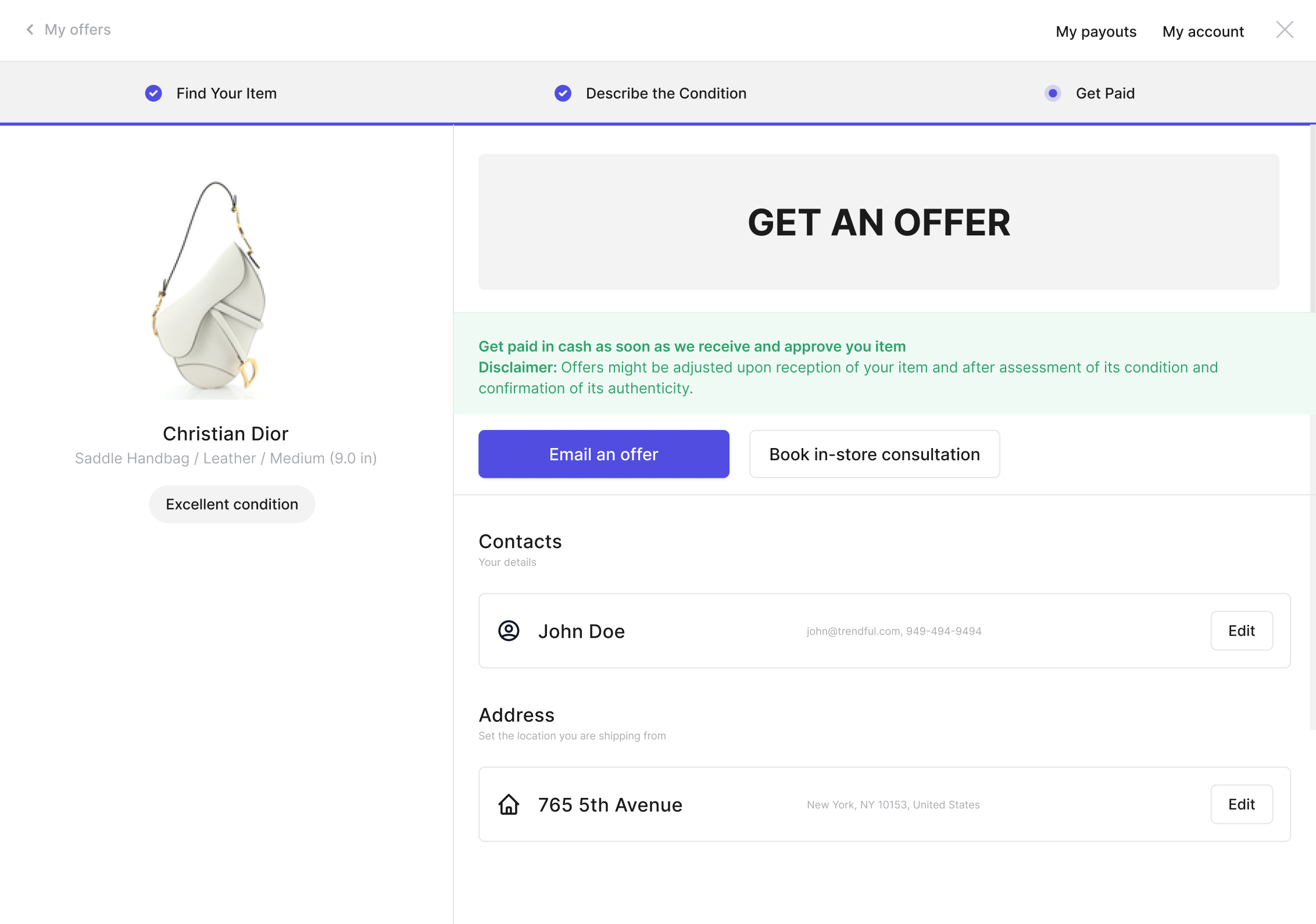
You can also decide to refuse specific items. For handbags, you can refuse items based on models and styles. For example, if for any reason at any given time you don’t want to accept Louis Vuitton Speedy Handbags, we can update your pricing strategy to display the following message:
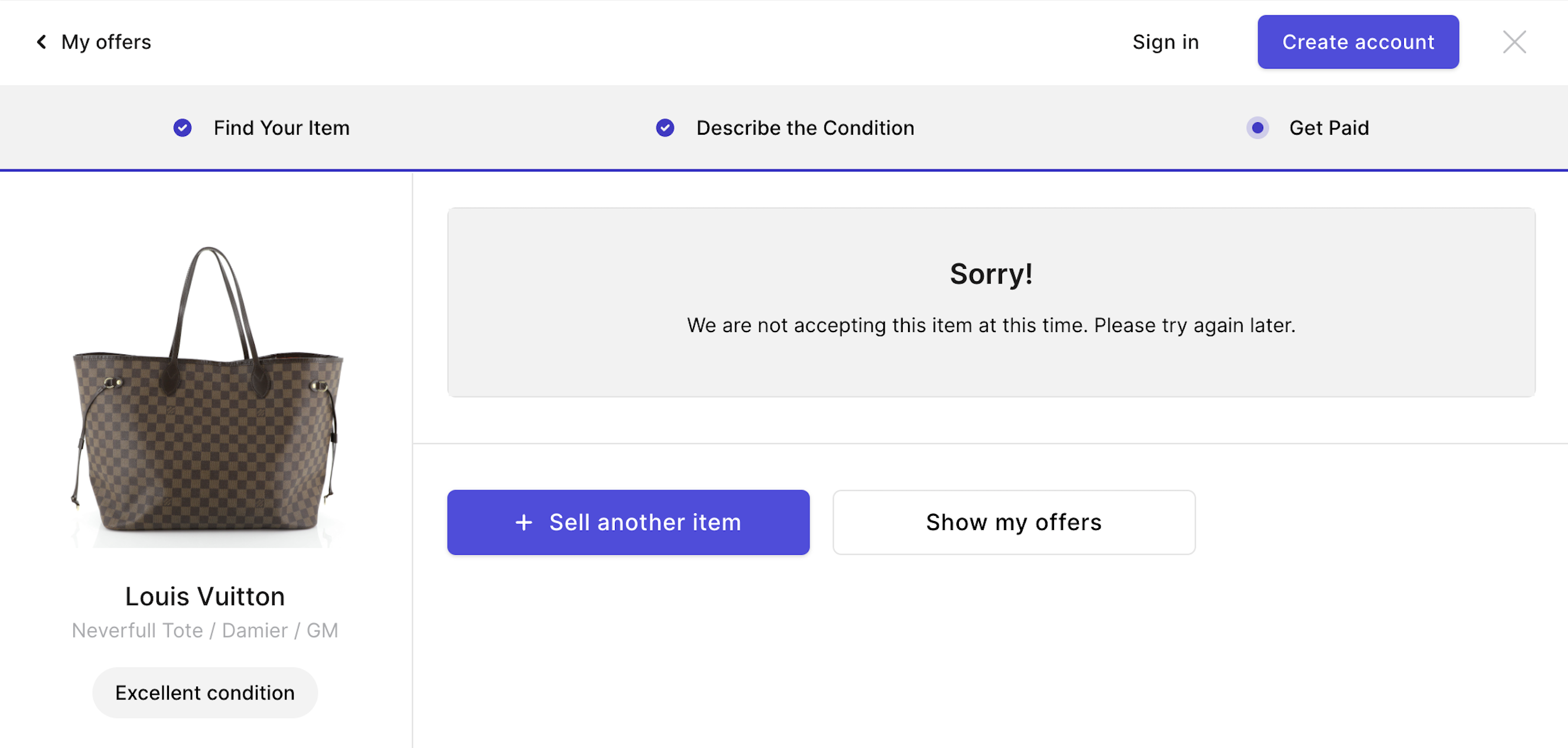
How do I choose a pricing strategy?
Now, you might wonder what is the right pricing strategy for your business.
Market Overview
In the secondary market, there is not a "normalized" commission structure for buyout, consignment nor credit offers that businesses are using. The pricing strategy and commission structures vary from one business to another. Therefore, the pricing strategy you choose is specific to your business.
Larger retailers such as Rebag and Fashionphile have very specific commission structures and aren't always transparent about it. For buyout offers, their commission structure will vary depending on the designer, the model, and their inventory levels. Then, the rate applied for a specific model of bag will vary over time too. Commission structures they take can range from 40%-60%. For consignments, you will usually find that they take these commission rates:
- Fashionphile: 30% for items up to a sale price of $3000 and 15% for the portion of the sale price over $3000
- TheRealReal: 60% for items estimated less than $145, 30% for items estimated between $1000-$4999, and 20% for items estimated over $5000 (it also depends on your reward program)
Other retailers may have a simple commission structure (for example, 50%/50% for buyouts and 60%/40% for consignments) whereas others will define different commission rates depending on the designer and/or the price range. On average, businesses’ target markups for buyout offers tend to be higher than for consignments or credit offers.
Business Analysis
As a business, you need to respond to a few questions related to how you acquire and resell inventory in order to decide what are the right commission structures for your needs:
- What are your current sources of inventory: buyouts, consignments, credits or wholesale?
- What are your current average target markups for each inventory stream?
Usually, sourcing wholesale helps you to ensure your incoming flow of inventory but, because of intermediaries, the item cost is on average higher. Therefore, the difference between the resale price and the item cost, that defines your target markup, is lower. On the other hand, sourcing from your customers generally leads to higher target markups, especially for buyouts. You can use the past sales data to compute your sell-through rate (how long it takes to resell) and average target markups (how much profit you make) for each inventory stream.
- How important is each inventory stream?
For example, 25% of your inventory might be wholesale-sourced and 75% customer-sourced. This means that you might have gained the trust of your customer base to resell their items and you might have educated them to comply and use your reselling process. Consequently, you can know what types of items (based on the designer and price range) you are more likely to receive depending on each of your inventory streams. Otherwise, you will need to use the data that you have and try different commission structures before finding the one that works the best for your business.
- *Are you intending to grow your business by opening and/or promoting new inventory streams?*
If your business was mostly reliant on wholesale to source inventory, however, you want to extend your inventory sourcing strategy to the customer streams (buyouts, consignments, and credits), you still need to understand what your customer niche wants. We tackle this point through the rest of the guide. Nonetheless, if you decide to acquire inventory directly from customers by using the Resale App, you will need to market it to collect data and make the most of this tool at the same time. For more information about marketing the interface, read our introduction to how to market the Resale App guide.
- *What does your customer niche look at and buy the most?*
Your customers might have a preference for specific designers: you know it because they sell more of them, faster and/or with better target markups. Your customers might also be looking for very popular items (i.e. iconic Chanel Boy Flaps or Louis Vuitton Neverfull) or low entry point items (i.e. accessories or wallets). To find it out, you need to look at customer behavior patterns. You might find them in your sales or marketing data. Below we explain to you what data you need to collect.
Before analyzing your sales you need to collect the following data:
- The operational cost of an item: this includes the price at which you buy the item and any additional shipping/authenticating/listing costs
- The marketing cost of an item: this can be estimated using the total of your marketing spendings divided by the number of items you sell for a specific marketing campaign
- The price at which you have sold items
- The time between when an item was listed and when it sold (also called sell-through rate) or the number of items sold in a given time period (also called sales turnover)
Before analyzing your customer behavior patterns, you need to collect the following data:
- The items that sell the most
- The items that customers click on when visiting your website
- The type of marketing or promotion campaigns that drive customers to your website and/or increase your sales
- The type of items or advertising content (content showcasing a designer, fashion news or a blog article, etc.) that drive your customer to your website and/or increase your sales
These lists are not exhaustive, you can find other valuable data. Then, you can analyze these metrics based on the inventory source, the fair market value range of the item, and the designer. Depending on each category, you can see how one performs compared to another. For example, how do buyout sourced items sell compared to consignments? Or how many times customers click on Louis Vuitton items compared to Gucci’s?
This should help you understand what your customer niche wants and how your business is performing, and give you indications to build your own pricing strategy.
Business case studies
Case Study 1
“40% of my sales are Gucci handbags and the average delay to sell a Gucci handbag is 2 weeks”
You got it, it seems Gucci is performing well on your website. You sell a lot and fast. It means that you can give consignments and buyout offers at low risk. You can even give very competitive buyout offers by lowering your target markup for this option while still having a commission structure for this offer option that guarantees that you make better target markups than for consignments. At this point, it’s even
In this scenario, we suggest:

Case Study 2
“When I create marketing content featuring Louis Vuitton, customers on average click 3 times more on my ads. It also increases my sales by 20% across all designers and 50% for items with a resale price below $500.”
This means that Louis Vuitton is a good designer to not only help increase your traffic but also potentially your sales, however, Louis Vuitton is not necessarily what sells. You should make sure that you have some Louis Vuitton handbags in your inventory but you do not necessarily have to acquire a lot of them.
However, it seems, if you intend to organize a campaign featuring Louis Vuitton, it would be good to acquire low price items, such as accessories and wallets, beforehand.
In this scenario, we suggest:

Case Study 3
“I sell a few Prada items every month, but it generally takes up to 3 months to sell them.”
It seems Prada is not your best-selling designer and that your sell-through rate for this designer is pretty high. It doesn’t mean you should stop selling Prada or that you should remove Prada from the designers on your Resale App. In fact, it's best to offer a diverse inventory so you are able to capture new customers. Also, your customers should have the opportunity to sell Prada if they want to, this way they are less likely to go to another website to try to sell their item. However, in this scenario, you should make sure to keep your target markups high, especially for buyout and credit options, as they both represent capital that is frozen until you resell the item for a profit or the customer uses their credit and additional cash to buy an item.
In this scenario, we suggest:

These case studies are meant to help explain to you a concept and aim to help you understand how to create your own pricing strategy. They are not meant to force you to use a specific commission structure. As a business owner, you are the best suited and only one to be able to collect and analyze your business metrics and decide accordingly on a pricing strategy.
Conclusion
There is not a simple recipe to come up with the right pricing strategy for your business. However, knowing your sales and customer behavior metrics will help you to define the commission structures that will allow you to acquire inventory that will guarantee you convert more customers into buyers as well help make you profits. We hope this guide helps you to create a pricing strategy that fits your business structure and needs!